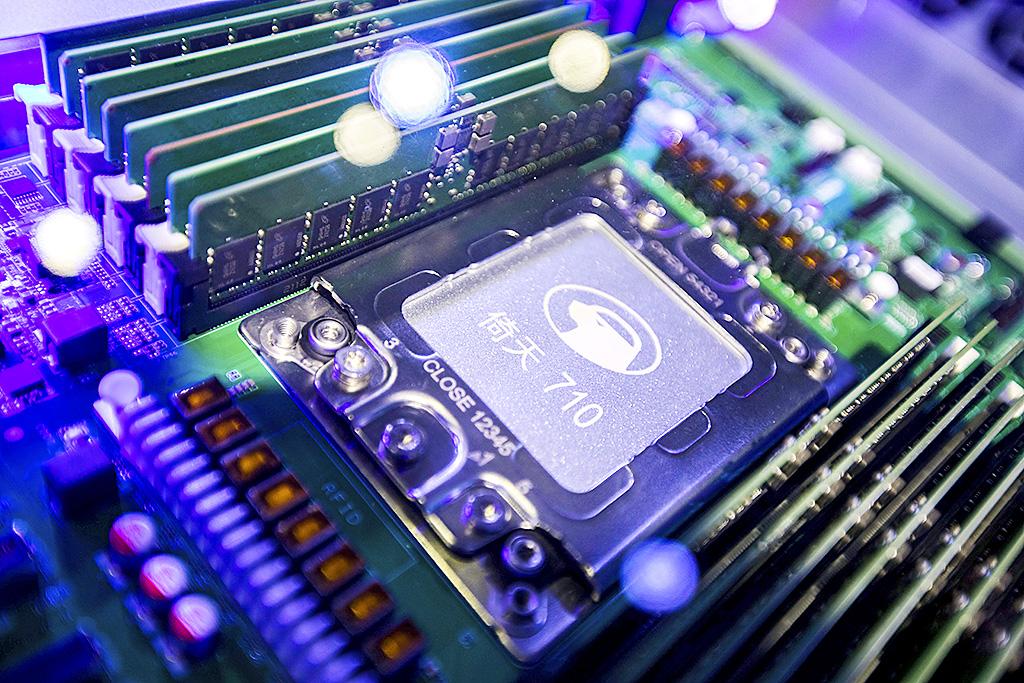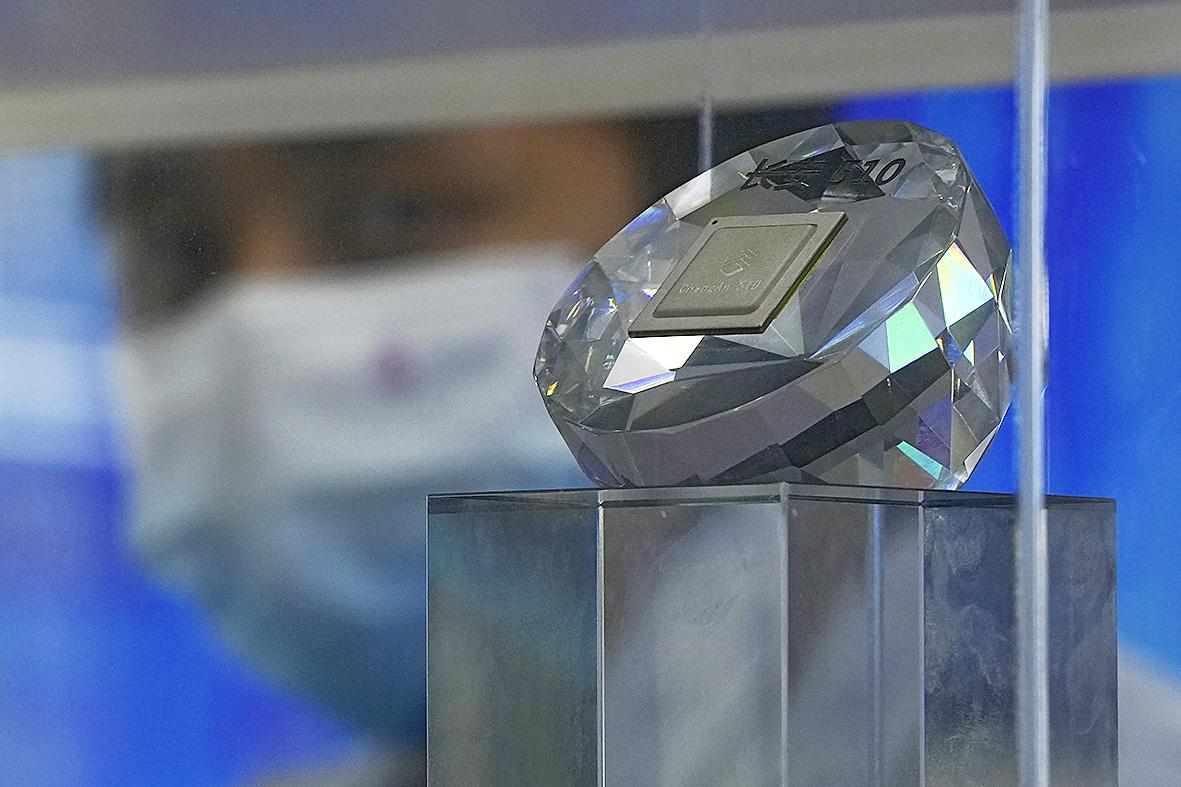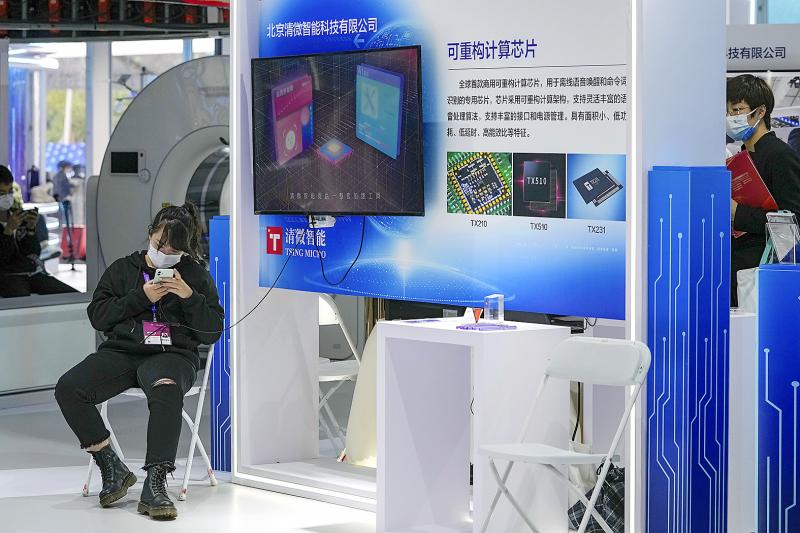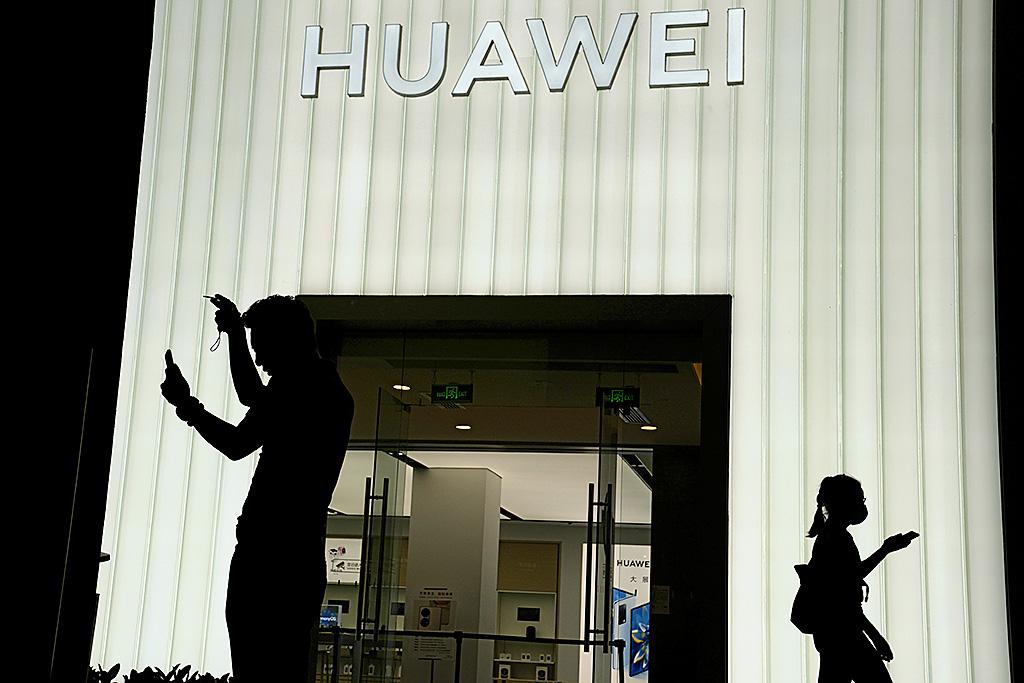To help make China a self-reliant “technology superpower,” the ruling Chinese Communist Party is pushing the world’s biggest e-commerce company to take on the tricky, expensive business of designing its own processor chips — a business unlike anything Alibaba Group (阿里巴巴) has done before.
Its 3-year-old chip unit, T-Head, unveiled its third processor in October, the Yitian 710 for Alibaba’s cloud computing business. Alibaba says for now, it has no plans to sell the chip to outsiders.
Other rookie chip developers including Tencent (騰訊), a games and social media giant, and smartphone brand Xiaomi (小米) are pledging billions of dollars in line with official plans to create computing, clean energy and other technology that can build China’s wealth and global influence.

Photo: AP
Processor chips play an increasingly critical role in products from smartphones and cars to medical devices and home appliances. Shortages due to the coronavirus pandemic are disrupting global manufacturing and adding to worries about supplies.
Chips are a top priority in the Communist Party’s marathon campaign to end China’s reliance on technology from the US, Japan and other suppliers Beijing sees as potential economic and strategic rivals. If it succeeds, business and political leaders warn that might slow down innovation, disrupt global trade and make the world poorer.
“Self-reliance is the foundation for the Chinese nation,” President Xi Jinping (習近平) said in a speech released in March. He called for China to become a “technology superpower” to safeguard “national economic security.”

Photo: AP
“We must strive to become the world’s main center of science and the high ground of innovation,” Xi said.
COSTLY DISAPPOINTMENT?
Beijing might be chasing a costly disappointment. Even with huge official investments, businesspeople and analysts say chipmakers and other companies will struggle to compete if they detach from global suppliers of advanced components and technology — a goal no other country is pursuing.

Photo: AP
“It’s hard to imagine any one country rebuilding all of that and having the best technology,” said Peter Hanbury, who follows the industry for Bain & Co.
Beijing’s campaign is adding to tension with Washington and Europe, which see China as a strategic competitor and complain it steals technology. They limit access to tools needed to improve its industries.
If the world were to decouple, or split into markets with incompatible standards and products, US or European-made parts might not work in Chinese computers or cars. Smartphone makers who have a single dominant global operating system and two network standards might need to make unique versions for different markets. That could slow down development.

Photo: AP
Washington and Beijing need to “avoid that the world becomes separated,” UN Secretary-General Antonio Guterres said in September.
China’s factories assemble the world’s smartphones and tablet computers but need components from the US, Europe, Japan, Taiwan and South Korea. Chips are China’s biggest import, ahead of crude oil, at more than US$300 billion last year.
Official urgency over that grew after Huawei Technologies Ltd.(華為), China’s first global tech brand, lost access to US chips and other technology in 2018 under sanctions imposed by the White House.

Photo: AP
That crippled the telecom equipment maker’s ambition to be a leader in next-generation smartphones. American officials say Huawei is a security risk and might aid Chinese spying, an accusation the company denies.
A DECADE BEHIND
Huawei and some Chinese rivals are close to matching Intel Corp., Qualcomm Inc., South Korea’s Samsung Electronics and Britain’s Arm Ltd. at being able to design “bleeding edge” logic chips for smartphones, according to industry analysts.
But when it comes to making them, foundries such as state-owned SMIC (中芯) in Shanghai are up to a decade behind industry leaders including TSMC (台積電), or Taiwan Semiconductor Manufacturing Corp., which produces chips for Apple Inc. and other global brands.
Even companies such as Alibaba that can design chips likely will need Taiwanese or other foreign foundries to make them. Alibaba’s Yitian 710 requires precision no Chinese foundry can achieve. The company declined to say which foreign producer it will use.
“My country still faces a big gap in chip technology,” said industry analyst Liu Chuntian of Zero Power Intelligence Group.
China accounts for 23 percent of global chip production capacity but only 7.6 percent of sales.
Packing millions of transistors onto a fingernail-size sliver of silicon requires some 1,500 steps, microscopic precision and arcane technologies owned by a handful of US, European, Japanese and other suppliers.
They include KLA Corp. in California for super-precise measurement and Japan’s TEL for machines to apply coatings a few molecules thick. Many are covered by restrictions on “dual use” technologies that can be used in weapons.
China “lags significantly” in tools, materials and production technology, the Semiconductor Industry Association said in a report this year.
Washington and Europe, citing security worries, block access to the most advanced tools Chinese chipmakers need to match global leaders in precision and efficiency.
Without those, China is falling farther behind, said Bain’s Hanbury.
“The TSMC horse is sprinting away and the Chinese horse is stopped,” he said. “They can’t move forward.”
Washington stepped up pressure on Huawei last year by barring global foundries from using American technology to produce its chips. US vendors can sell chips to the company, but not for next-generation “5G” smartphones.
For its part, the EU said it will review foreign investments after complaints China was eroding Europe’s technology lead by purchasing important assets such as German robot maker Kuka.
NO DETACHING
Alibaba’s Yitian 710 is based on architecture from Britain’s Arm, highlighting China’s enduring need for foreign know-how. Alibaba said it still will work closely with longtime foreign suppliers Intel, Arm, Nvidia Corp. and Advanced Micro Devices, Inc.
T-Head’s first chip, the Hanguang 800, was announced in 2019 for artificial intelligence. Its second, the XuanTie 910, is for self-driving cars and other functions.
Last month, Tencent Holding, which operates the WeChat messaging service, announced its first three chips for artificial intelligence, cloud computing and video.
Beijing says it will spend US$150 billion from 2014 through 2030 to develop its chip industry, but even that is a fraction of what global leaders invest. TSMC plans to spend US$100 billion in the next three years on research and manufacturing.
China is trying to buy experience by hiring engineers from TSMC and other Taiwanese producers. Taiwan, which Beijing claims as part of its territory and has threatened to attack, has responded by imposing curbs on job advertising.
Beijing encourages smartphone and other manufacturers to use suppliers within China, even if they cost more, but officials deny China wants to detach from global industries.
“We will never go back in history by seeking to decouple,” Xi said in a speech by video link last month during a meeting of Asia-Pacific leaders in Malaysia.
The latest conflict is over photolithography, which uses ultraviolet light to etch circuits into silicon on a scale measured in nanometers, or billionths of a meter.
The leader is ASML in the Netherlands, which makes machines that can etch transistors just 5 nanometers apart. That would pack 2 million into a space 1cm wide.
China’s SMIC is about one-third as precise at 14 nanometers. Taiwan’s TSMC is preparing to increase its precision to 2 nanometers.
SMIC wants to upgrade by purchasing ASML’s latest machine, but the Dutch government has yet to agree.
“We will wait for their decision,” said an ASML spokeswoman, Monica Mols, in an E-mail.

May 11 to May 18 The original Taichung Railway Station was long thought to have been completely razed. Opening on May 15, 1905, the one-story wooden structure soon outgrew its purpose and was replaced in 1917 by a grandiose, Western-style station. During construction on the third-generation station in 2017, workers discovered the service pit for the original station’s locomotive depot. A year later, a small wooden building on site was determined by historians to be the first stationmaster’s office, built around 1908. With these findings, the Taichung Railway Station Cultural Park now boasts that it has

Wooden houses wedged between concrete, crumbling brick facades with roofs gaping to the sky, and tiled art deco buildings down narrow alleyways: Taichung Central District’s (中區) aging architecture reveals both the allure and reality of the old downtown. From Indigenous settlement to capital under Qing Dynasty rule through to Japanese colonization, Taichung’s Central District holds a long and layered history. The bygone beauty of its streets once earned it the nickname “Little Kyoto.” Since the late eighties, however, the shifting of economic and government centers westward signaled a gradual decline in the area’s evolving fortunes. With the regeneration of the once

The latest Formosa poll released at the end of last month shows confidence in President William Lai (賴清德) plunged 8.1 percent, while satisfaction with the Lai administration fared worse with a drop of 8.5 percent. Those lacking confidence in Lai jumped by 6 percent and dissatisfaction in his administration spiked up 6.7 percent. Confidence in Lai is still strong at 48.6 percent, compared to 43 percent lacking confidence — but this is his worst result overall since he took office. For the first time, dissatisfaction with his administration surpassed satisfaction, 47.3 to 47.1 percent. Though statistically a tie, for most

In February of this year the Taipei Times reported on the visit of Lienchiang County Commissioner Wang Chung-ming (王忠銘) of the Chinese Nationalist Party (KMT) and a delegation to a lantern festival in Fuzhou’s Mawei District in Fujian Province. “Today, Mawei and Matsu jointly marked the lantern festival,” Wang was quoted as saying, adding that both sides “being of one people,” is a cause for joy. Wang was passing around a common claim of officials of the People’s Republic of China (PRC) and the PRC’s allies and supporters in Taiwan — KMT and the Taiwan People’s Party — and elsewhere: Taiwan and